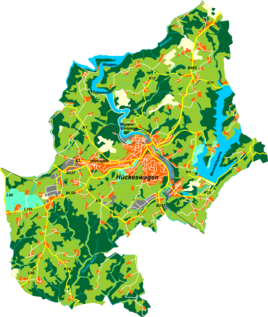Bridge (Hückeswagen)
|
bridge
City of Hückeswagen
Coordinates: 51 ° 9 ′ 17 ″ N , 7 ° 20 ′ 36 ″ E
|
||
|---|---|---|
| Height : | 259 m above sea level NN | |
| Postal code : | 42499 | |
| Area code : | 02192 | |
|
Location of the bridge in Hückeswagen |
||
|
View of town in bridge
|
||
Brücke is a district of Hückeswagen in the Oberbergischer Kreis in the administrative district of Cologne in North Rhine-Westphalia ( Germany ).
Location and description
Brücke is located near the main town of Hückeswagen north of the center on the Wupper . Other neighboring towns are Schnabelsmühle , Fuhr , Aue , Bergerhof , Frohnhausen and Pixberg . The place is on the district road K11 between the main town and Pixberg, the Frohnhauser Bach flows here into the Wupper pre-dam of the Wuppertalsperre .
The bridge emerged from the expanding city center, which at this point crossed the Wupper. The name of the place is derived from the Wupperbrücke, the forerunner of which was built at this point in the Middle Ages. The Wupper pre- dam has its dam here . On both sides of the Wupper there is a permanent artistic installation that was donated by local metal construction companies.
history
In 1481 the place was mentioned for the first time in the donation lists for the Marien Altar of the Hückeswagen church . The spelling of the first mention was Brüggen . The bridge is drawn in the Topographia Ducatus Montani map from 1715 and shows the courtyard under the name of the bridge . The place was on the Hückeswagen – Radevormwald section of a medieval military , trade and pilgrimage route , today's Buschweg .
In the 18th century the place belonged to the Bergisches Amt Bornefeld-Hückeswagen . In 1815/16 53 people lived in the village. In 1832, Brücke belonged to the Berghauser Honschaft , which was part of the Hückeswagen external citizenship within the Hückeswagen mayor's office . The place, categorized as a merchant's house according to the statistics and topography of the administrative district of Düsseldorf , had eight residential buildings and eight agricultural buildings at that time. At that time 61 people lived in the place, 47 Catholic and 14 Protestant faith.
In the municipality lexicon for the Rhineland province , 16 houses with 160 inhabitants are given for 1885. At that time the place belonged to the rural community Neuhückeswagen within the Lennep district .
Hiking and biking trails
The following hiking trails lead through the village or past it:
- the district hiking trail ◇ 6 ( Wupperweg ) of the SGV district Bergisches Land
- the road of work of the SGV district Bergisches Land
- the local hiking trail △ from Elberhausen to the Goldenbergshammer
- the local hiking trail ▲ from the center of Radevormwald to Purd
- the local hiking trail ━ from Purd to the Wiebach-Vorsperre
- the local ■ hiking trail from Kräwinklerbrücke to Hückeswagen center
- the local circular hiking trails A1, A2 and A3 (Frohnhauser Bachtal)
Individual evidence
- ^ Klaus Pampus: First documentary naming of Oberbergischer places (= contributions to Oberbergischen history. Sonderbd. 1). Oberbergische Department 1924 eV of the Bergisches Geschichtsverein, Gummersbach 1998, ISBN 3-88265-206-3 .
- ^ Johann Georg von Viebahn : Statistics and topography of the administrative district of Düsseldorf. Part 2: Containing the statistical table of places and distances and the alphabetical index of place names. Schreiner, Düsseldorf 1836, p. 13 .
- ^ Royal Statistical Bureau (Prussia) (Ed.): Community encyclopedia for the Rhineland province. Based on the materials from the census of December 1, 1885 and other official sources (= community encyclopedia for the Kingdom of Prussia. Vol. 12, ZDB -ID 1046036-6 ). Publishing house of the Royal Statistical Bureau, Berlin 1888.



